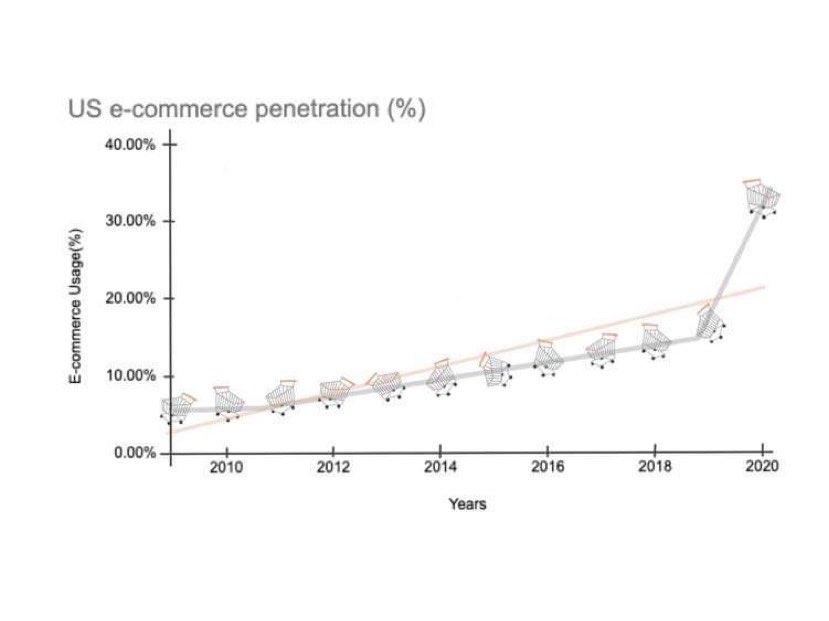As the initial panic hoarding of toilet paper, masks and hand sanitizer begins to subside, COVID-19 still has a profound impact on the average shopping experience. Lockdowns and social distancing measures have discouraged shoppers from going out and shopping in person, and as a result, many have turned exclusively to online shopping.
A study conducted by JLL research in Aug. 2020 showed the percentage of retail sales through online channels had grown 11% annually for the past 10 years. However, in just the past year, this rate soared to 118%, and the weight of this dramatic and sudden increase in online shopping has been placed squarely on the backs of drivers and couriers nationwide.
UPS driver Greg Matson said he was surprised by the increase of packages he delivered this year compared to previous years, especially during the holiday season.
“It was very busy … everyone was working six days a week delivering about 250 to 500 packages a day,” Matson said. “In terms of volume of packages, this year was headed above anything that anyone has ever experienced in terms of delivery.”
This holiday season, however, UPS was prepared for the sharp increase in demand for packages and hired additional help, something they have struggled to manage in past years, Matson said.
“This is the first year UPS really hired enough drivers,” Matson said. “I think they hired about 300 seasonal drivers and ride-along helpers at the Sunnyvale office. In the past, I heard that drivers used to work 16 or 17 hours a day because there was very limited help, so I’m glad UPS hired more people.”
This shift to online shopping hasn’t had an equal effect on shoppers across generations, though. The younger generations — Generations X and Z — who are either digital natives or have had previous experience with shopping online, had an easier time adapting to it, junior Khushi Agarwal and parent Lisa Berens said.
But Paly grandmother Maria Jeon said older generations who aren’t as familiar with digital commerce have struggled to navigate through online shopping.
Jeon said her complex journey of transitioning to online shopping included countless YouTube tutorials and a tutoring session offered by her granddaughter.
“It was hard because I had never done any online shopping before the pandemic,” Jeon said. “It took me about two months to be able to navigate through the Whole Foods website and purchase what I want. I still get stuck sometimes, but I mostly got the hang of it.”
Born in 1948, Jeon said she had virtually no experience using technology until 2010, when she purchased her first Apple smartphone. However, even with a phone, Jeon said she prefers to write letters instead of emails and talk in person rather than on a call. Jeon’s stance on online shopping is no different.
“After the pandemic is over, I would love to go back to the grocery store and be able to buy my groceries in person again,” Jeon said. “Online shopping is not something that I particularly enjoy.”
Contrary to Jeon’s difficult experience adapting to online shopping, Berens and Agarwal of Generation X and Z, respectively, say they had no issues transitioning.
Berens said she enjoyed the process of researching grocery stores and purchasing items in just minutes, all from the comfort of her home.
“It is really convenient to be able to order groceries online and have them delivered to your house on the same day,” Berens said. “Before COVID-19, I didn’t even know these services were available.”
Similarly to Berens, Agarwal, too, said she experienced no difficulties as she was already accustomed to online clothes shopping before COVID-19 hit. In fact, she said she prefers online over in-person shopping because of the larger variety of clothes and added convenience.
“I actually don’t remember the last time I went in-person shopping,” Agarwal said. “I feel like it’s harder to shop in-person because you can’t always find the right size or color. But shopping online allows you to see all of your options right away and it saves a lot of time.”
So while the adaptations to online shopping have been a different experience for all three generations, it is unclear whether people will continue to shop online at the same rate after the pandemic ends.
“I look forward to the future of online shopping,” Berens said. “I think it will be very interesting to see how shopping in general will be impacted by the pandemic.”

